Mephisto CD transport from Audiomeca.

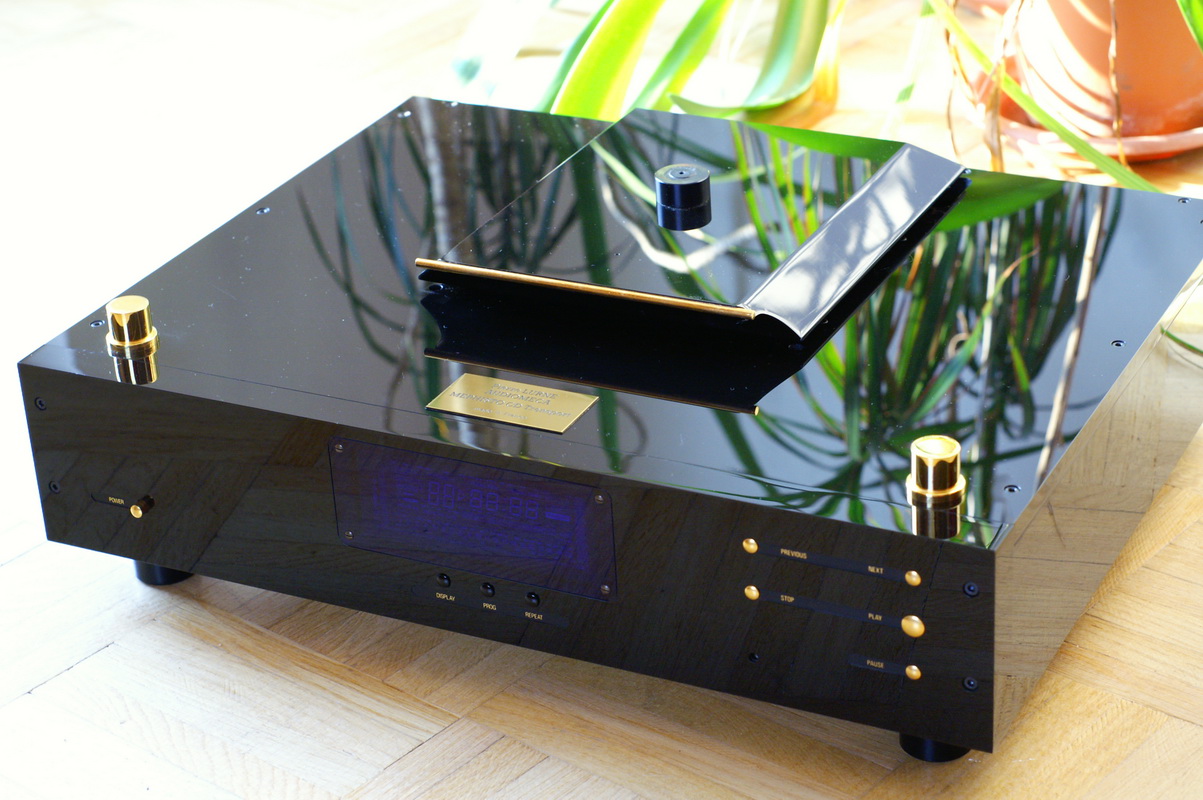
(this is not my photo - forgive me whoever I stole it from)
Mephisto is the first "proper " CD transport that I ever saw and it's
beauty and sound blew my mind. That was 17 years ago. Today in my
(blown then) mind - it occupies the position of transport benchmark and
a secret dream.
I also admit to be under the spell of Pierre Lurne's legends about how
much rocket science is inside his players.
In the Mephisto2 I found a stock Sanyo
pcb and mechanism plus some chrome, but what's inside the first and
genuine Mephisto 1 ? Let's find out.
Enter MEPHISTO - is it from heaven or is it from hell?
First - listening impression.
Mephisto 2 in stock form seriously beats the Mephisto 1 on sound
comparison, even if the Mephisto1 has ALL CAPS upgraded to Black
Gates and it has an aftermarket Trichord2 clock with own transformer.
The
TWO is a better player - It has more resolution, more details,
better separation, better space, it is more involving overall.
Not that Mephisto 1 is bad - far from that, but it is not impressive
either.
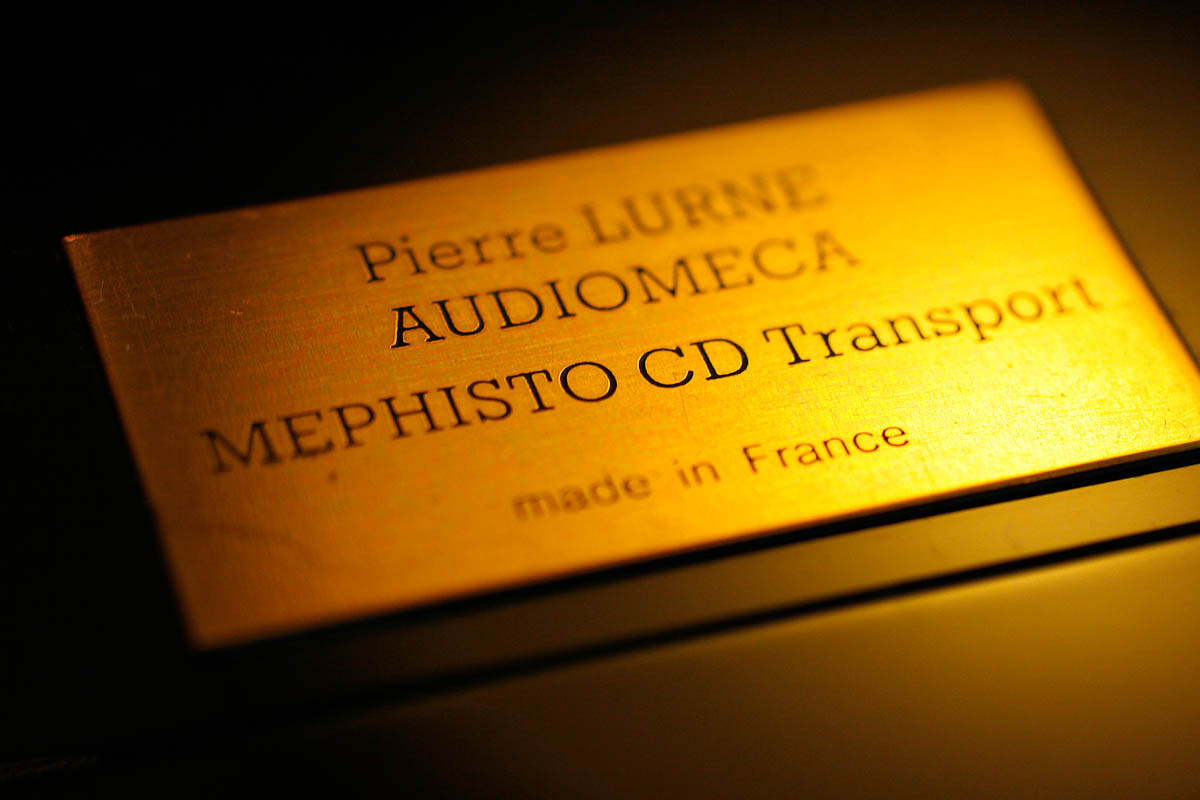
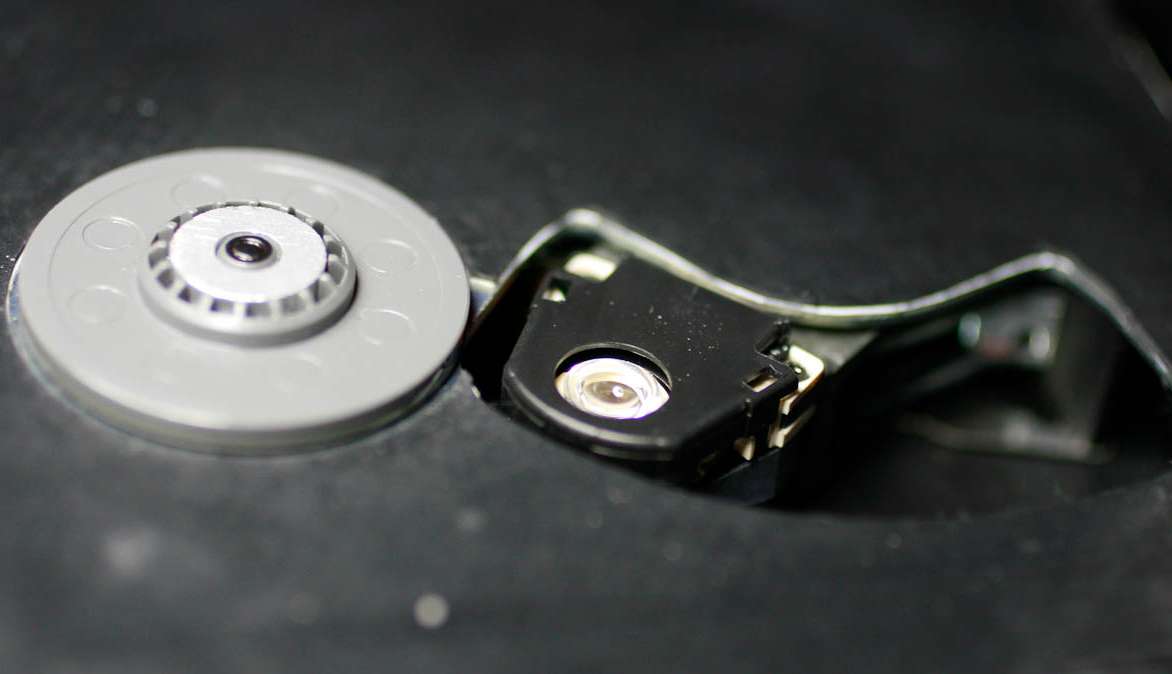
Upon closer inspection what I found out is that:
Mephisto 1 mechanism - laser and all laser electronics - are 100% pure
stock
Philips CDM9 (non-PRO) kit.
The mechanical suspension is improved by means of four sponge
balls on which the assembly hangs. That's a nice addition to the stock
form.
The display (very very nice) is a stock Philips display with a
corresponding stock Philips controller PCB.
The demodulation and S/PDIF forming is done by means of some sort of
stock "CD industrial PCB" - an off the shelve product that Mr.
Lurne found somewhere. It is a nice pcb but again - nothing DEVILISH
there.
And finally - the two additions of Lurne to the stock Eindhoven
technology to be found elsewhere in any 50 Euro Philips player on ebay:
the power
supply and the output S/PDIF formation stage. Both are Audiomeca
proprietary.
OK, says the devilish part of me - what If I am smarter than Lurne and
I will better him in exactly the area where he wanted to better Philips?
Let's find out.
THE PLAN TO HOT ROD THE MEPHISTO
My plan is a very primitive one:
it consists of four basic stages of manipulation of which finally
I did only
two. (The third would be caps (oscons everywhere), fourth would be the
clock which is already in there)
1. To upgrade power supply to the critical points - chips responsible
for digital signal - from demodulator of laser impulses to S/PDIF
series data stream generator.
I identified 3 such chips on the "industrial CD PCB" . In order to do
this I will build a power supply three-pack - just like for my Fikus Transport
940
I tested the PSU for noise which is created by the stabilizing
regulators and it was horrible. I had to play hard to remove most of it
by using good caps, cokes, and a mix of good regulators with low noise.
2. to trace the signal of S/PDIF with the scope and see if it can be
cleaned up.
PHOTOS OF MEPHISTO 1 TRANSPORT
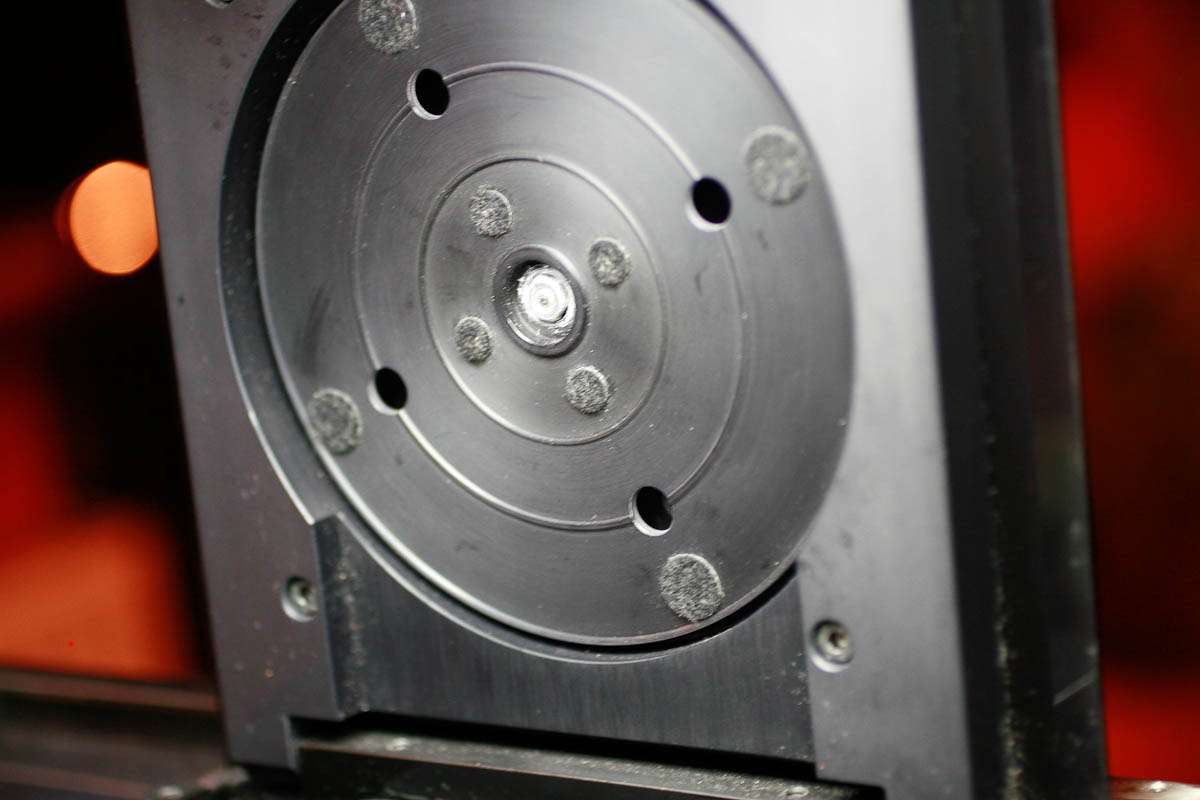
The big lid over the CD has a full size rotating plate that supports
the CD just like VRDS CMK4. This is the only player that I know of that
has such turntable, except the well known Pioneers and VRDS. Unlike
them both - this table is passive, it is turned by the CD, not
the other way around. So the motor and its spindle are normal - from
the bottom side up.
BE WARNED - this lid is heavy and it does not have spring or brakes -
if it FALLS DOWN on the mechanism - it will destroy it !!! One
false move, one vino too many - and the player is a door-stop.
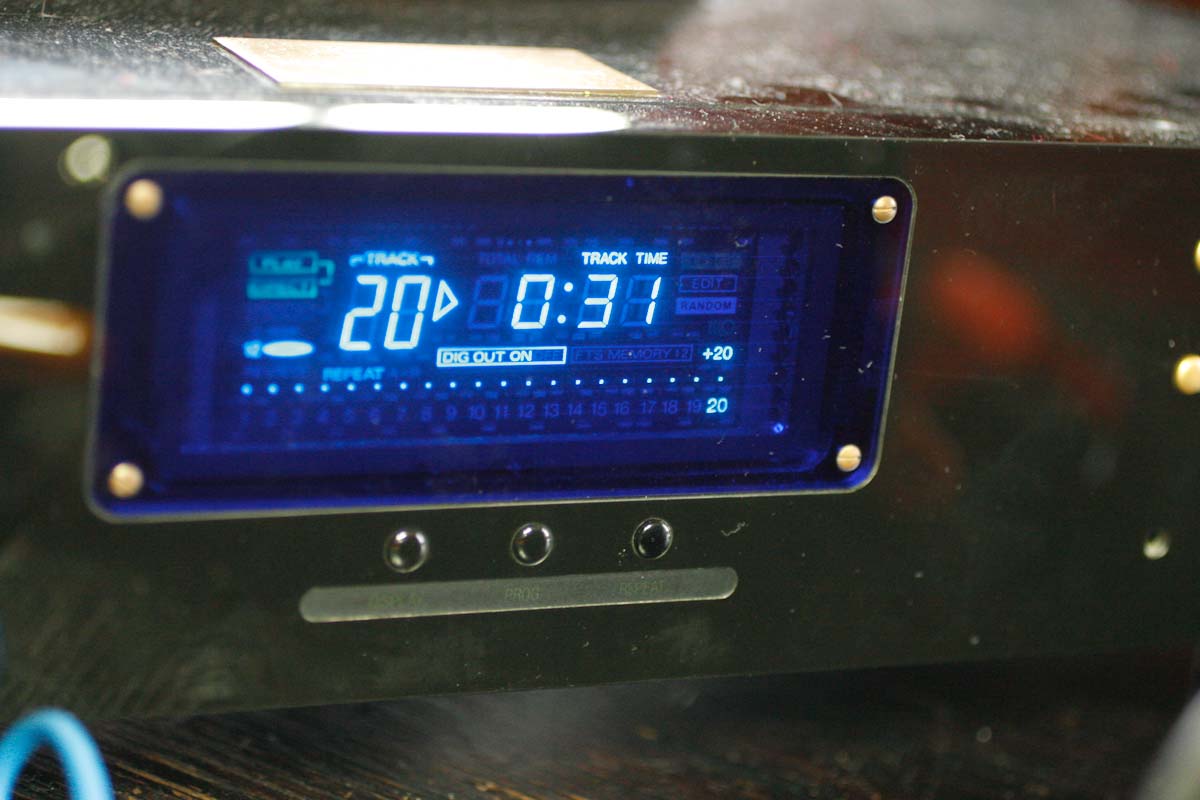
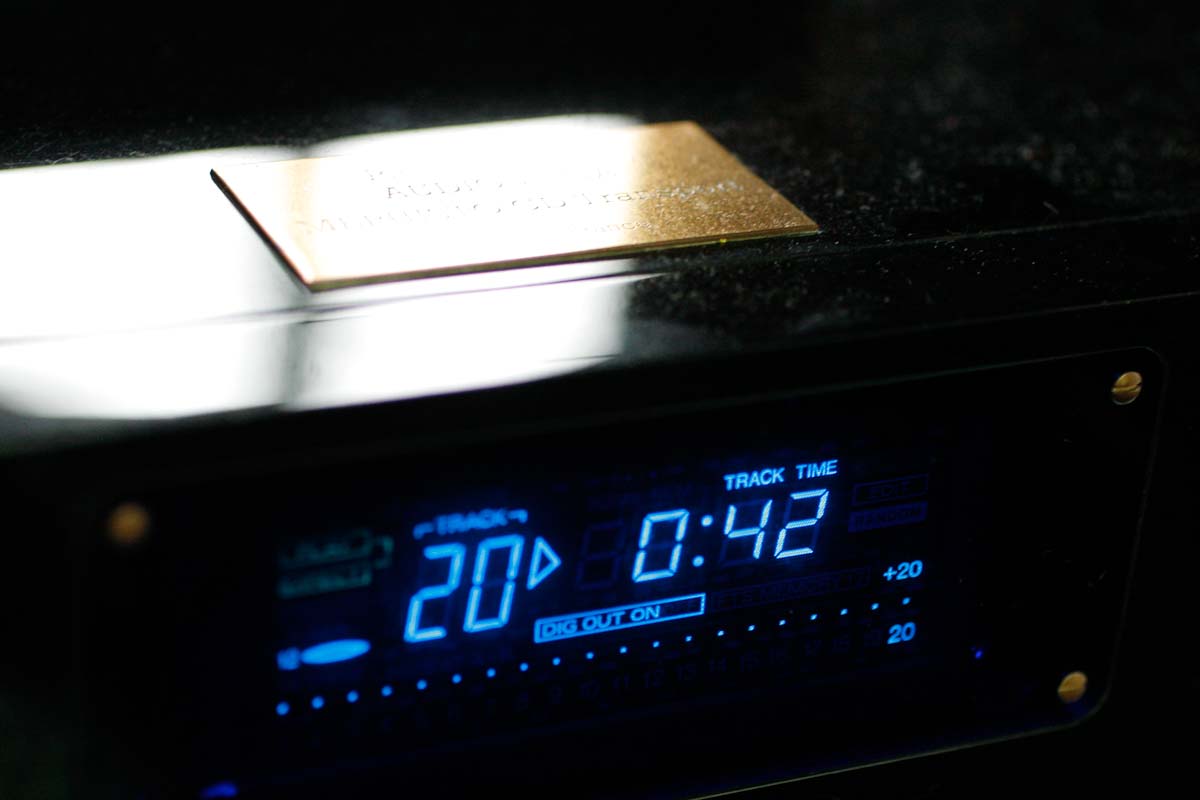
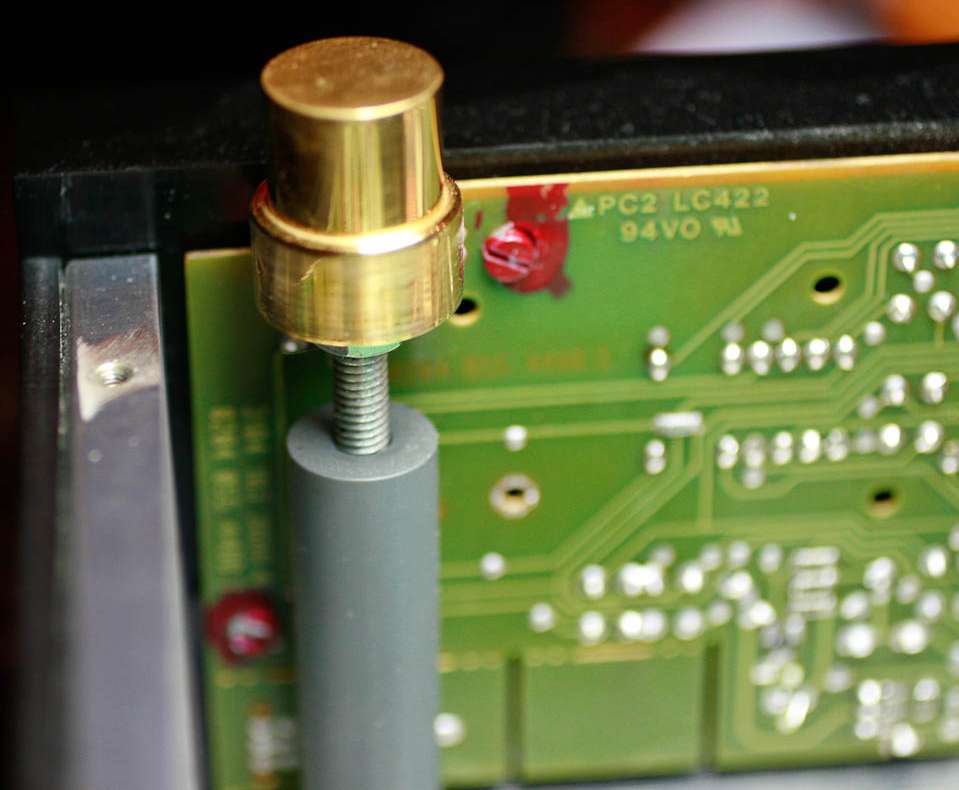
Another contribution from Mr. Lurne - sexy golden cups which allow
to move up and down the front legs and to level the player
perfectly.
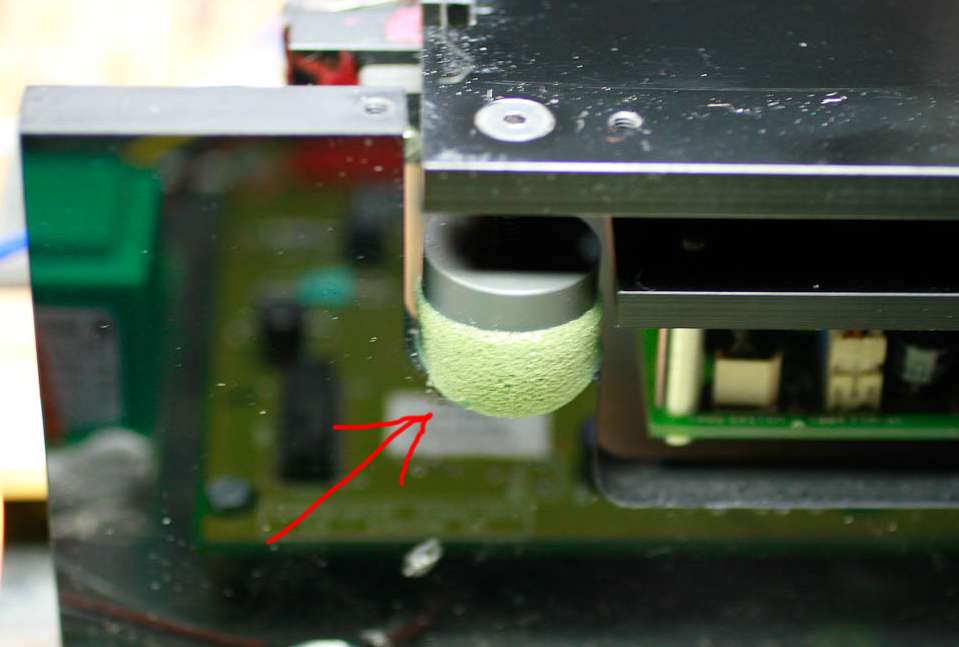
The arrow points to the sponge suspension of the player. Very nice
touch
but again - be warned - neoprene rotes after 10 years or so and soon -
your mechanism will be riding on the rotten foam.
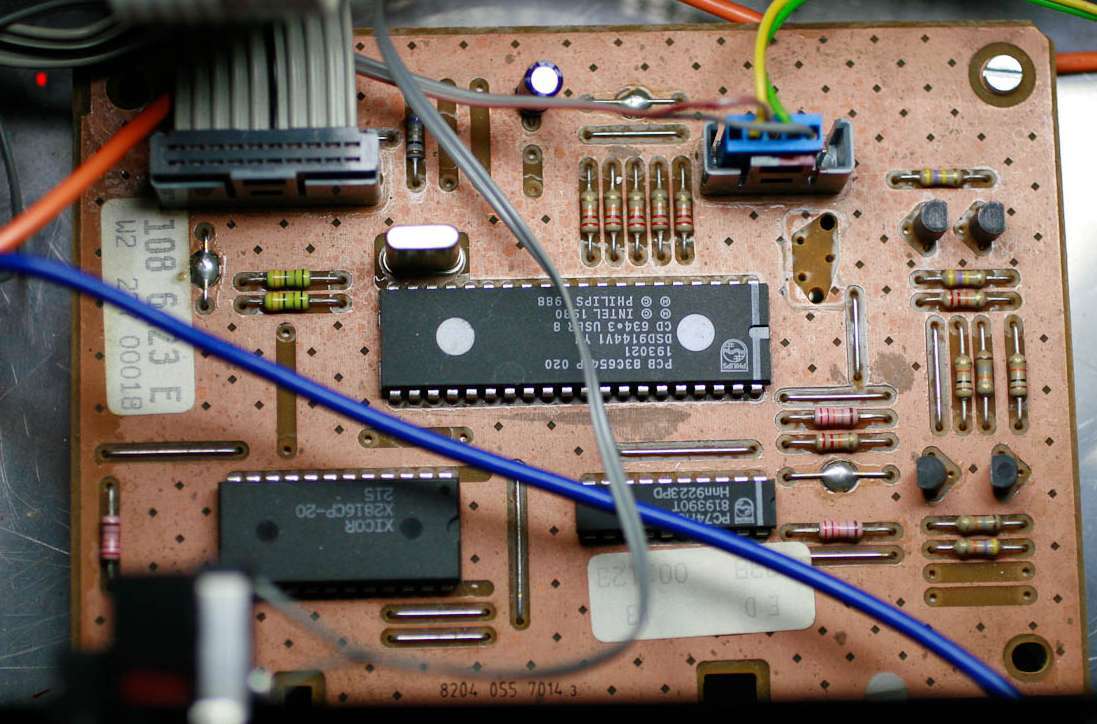
This is the display and mechanism microcontroller from standard Philips
player.
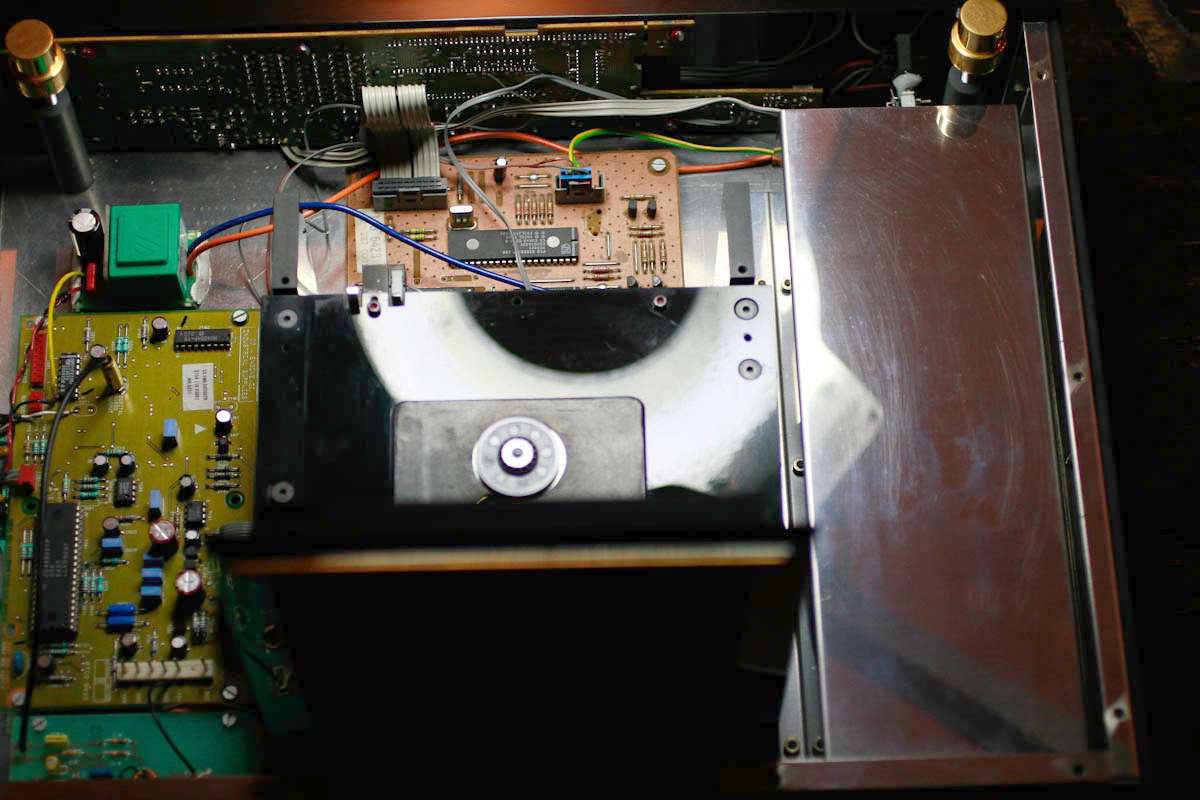
The general view on the whole Mephisto1 player
The green cube in the upper left corner is an aftermarket trichord
clock supply.
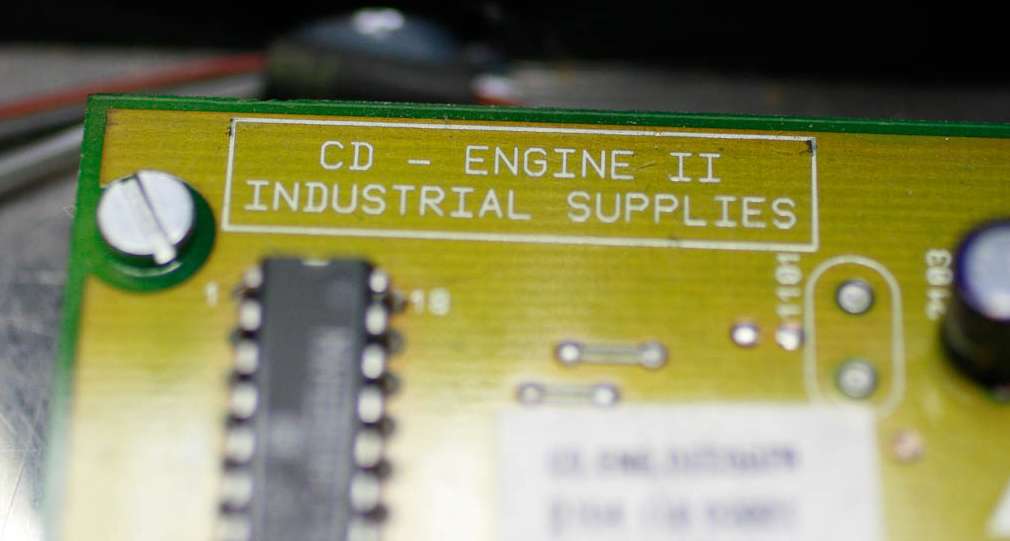
This PCB - crucial for the transport performance - is an off the shelve
kit solution.
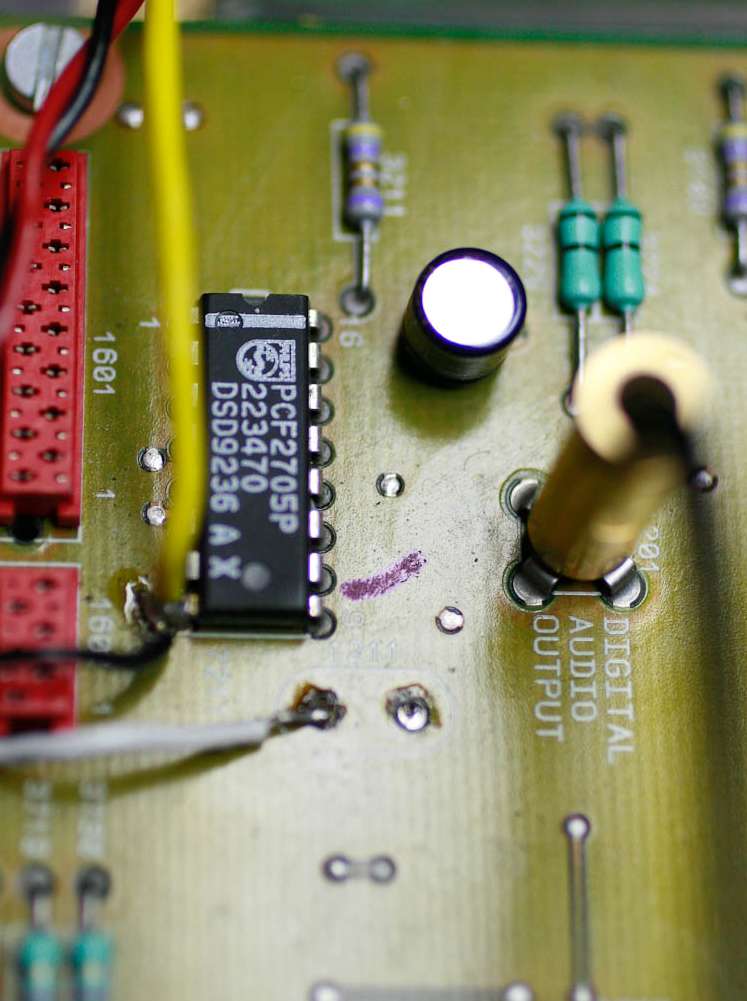
This chip produces S/PDIF. Note - white wire delivers the clock, black
mark - indicates leg 9th as the one which has Vdd supply of +5V.
Blue resistor near the leg 16th and a small black gate cap - are
the power input to this chip. This point we will upgrade.
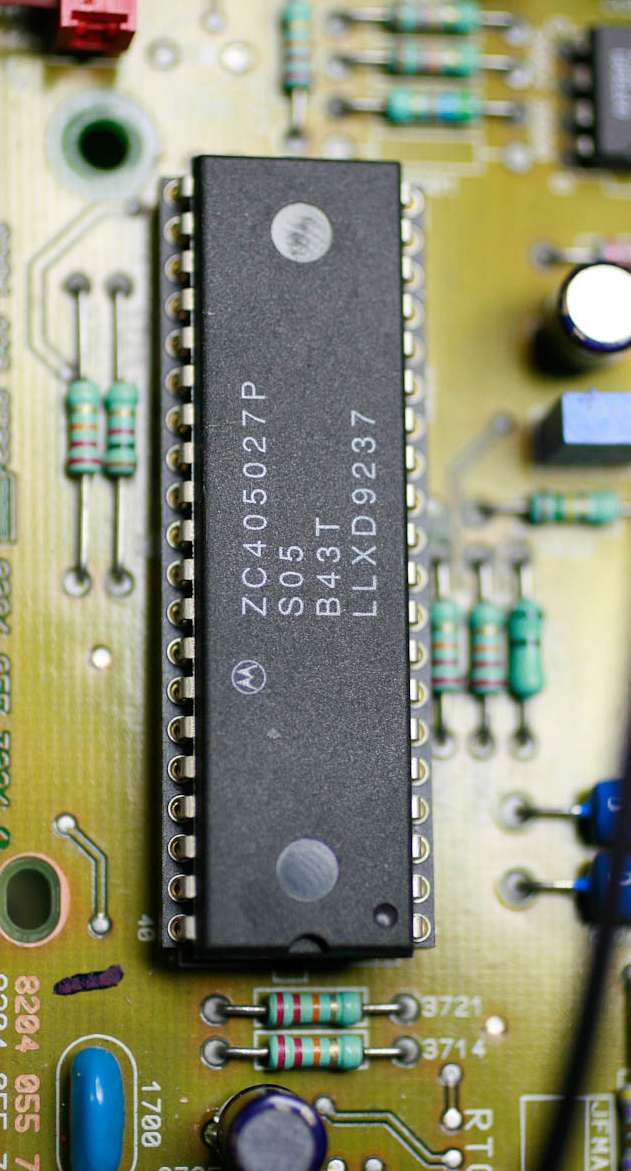
Another chip on the industrial CD board - I marked leg 40 as the one
with +5V and the round cap on the bottom is the supply Blackgate near
the (invisible here) 4,7 Ohm resistor. (not this very blue cap marked
1700).
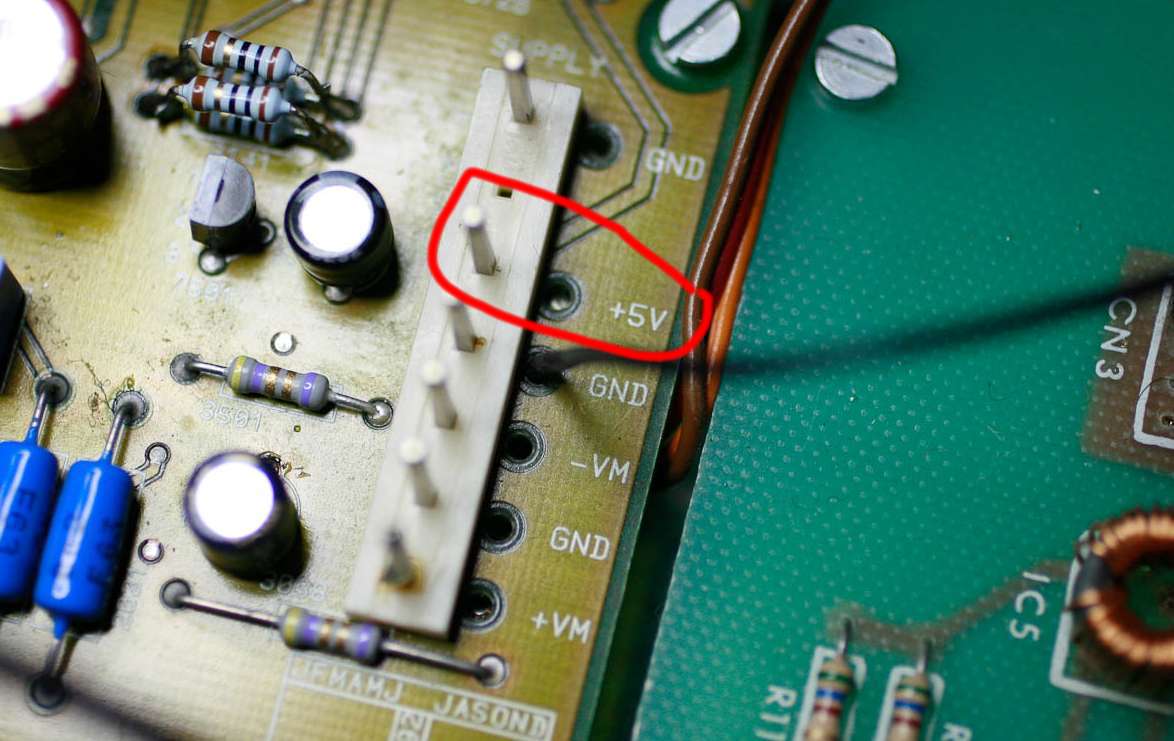
As you see - the industrial board has just one common input of the +5V.
So all the chips on this board can "talk to each other" via
the distortions on this common line.
My tuning will deal with this by providing three separate lines - so
each chip is supplied directly and independently.
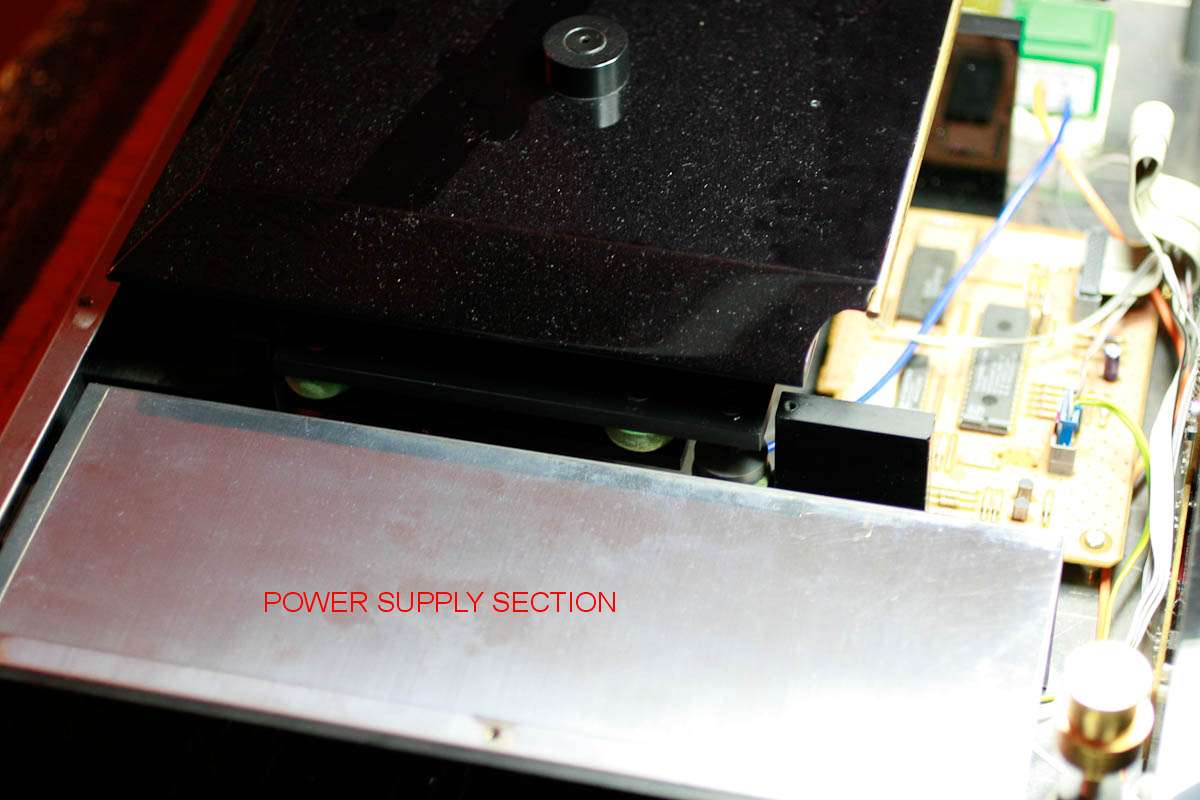
I removed the silver protection can covering the power supply.
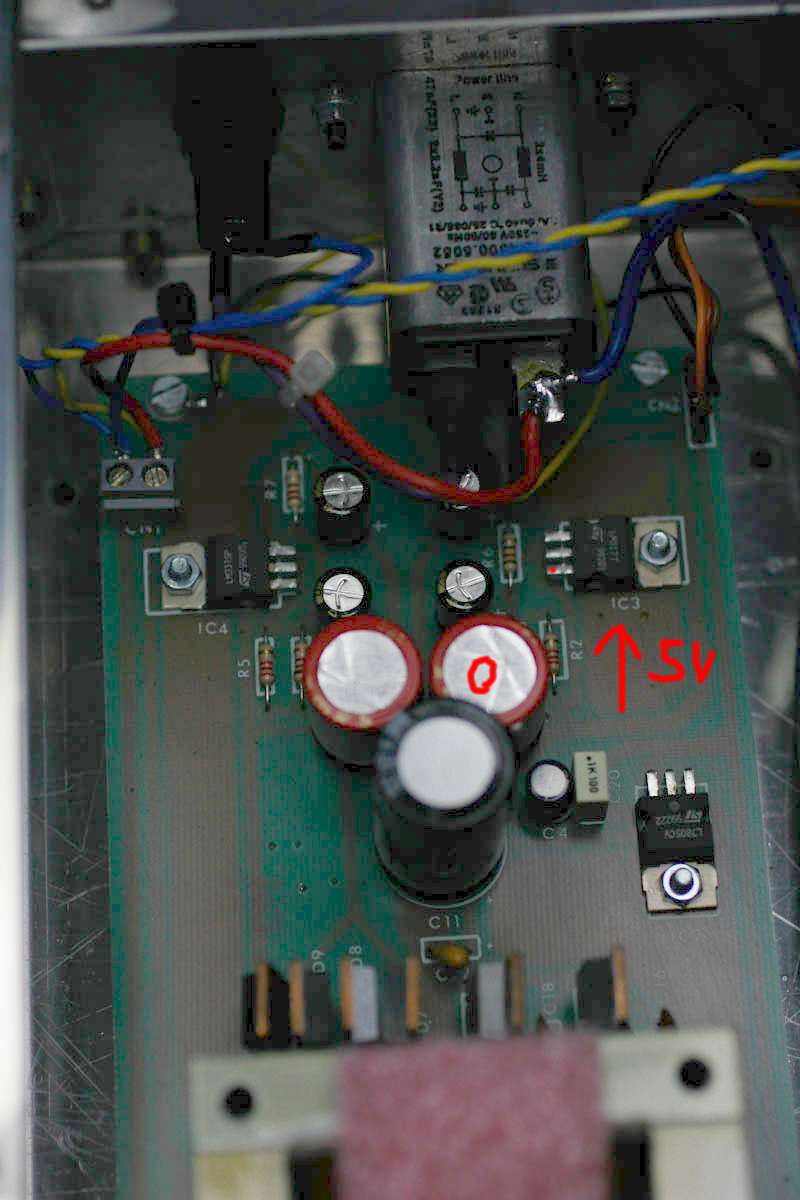
The supply has one transformer, 4 secondary voltages, 4 regulators (the
three legged chips which lie flat on the PCB. )
Someone before me - already put the black-gates everywhere.
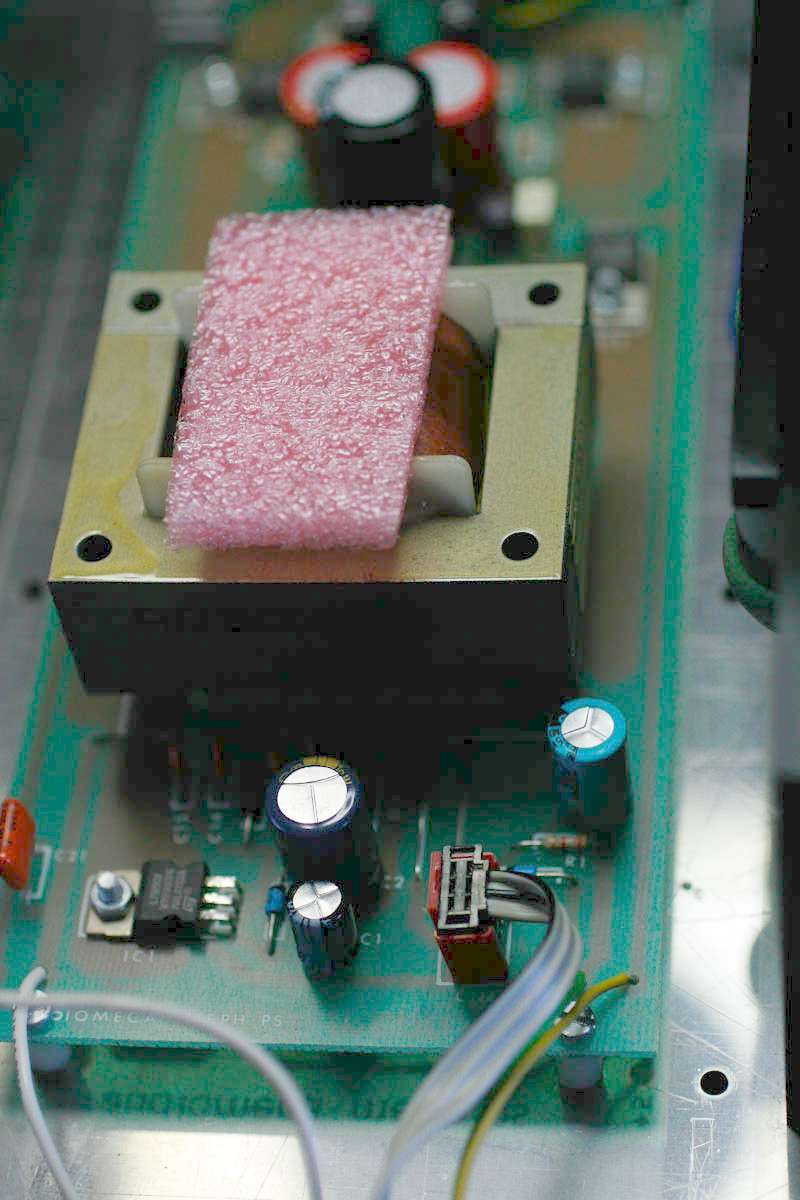
The transformer is big enough and good enough. Originally I planned to
upgrade it, but after seeing it - I decided to keep it.
The regulator on the above photo is a minus 18 V for the display
light. That idiot put black gates even in the display light
circuit. What a moron.
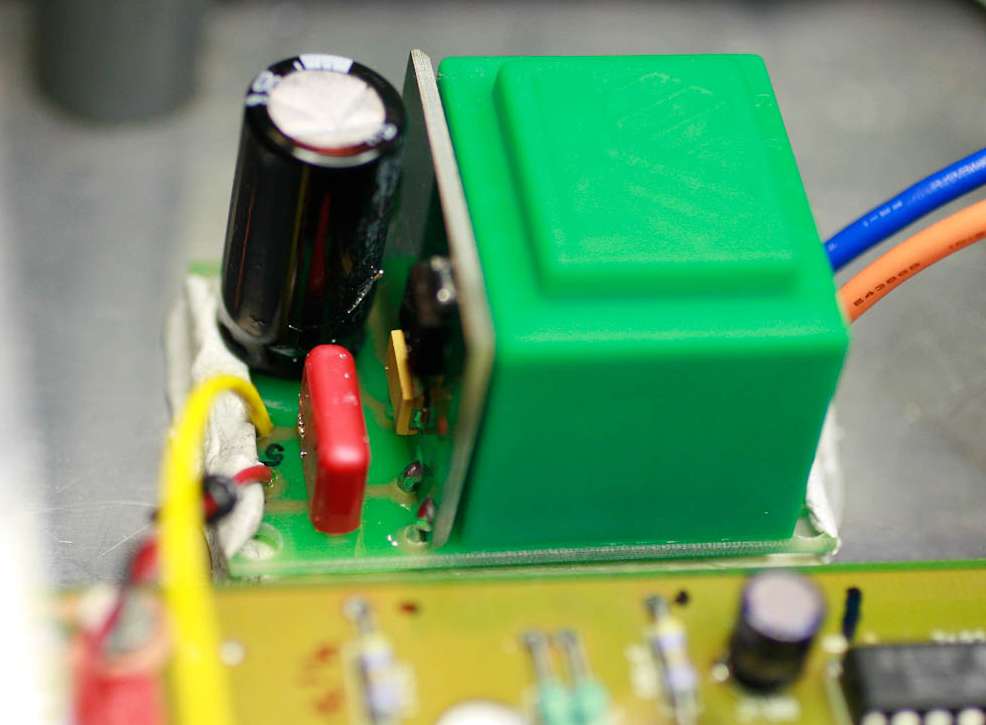
This is the clock supply transformer - 220/12V
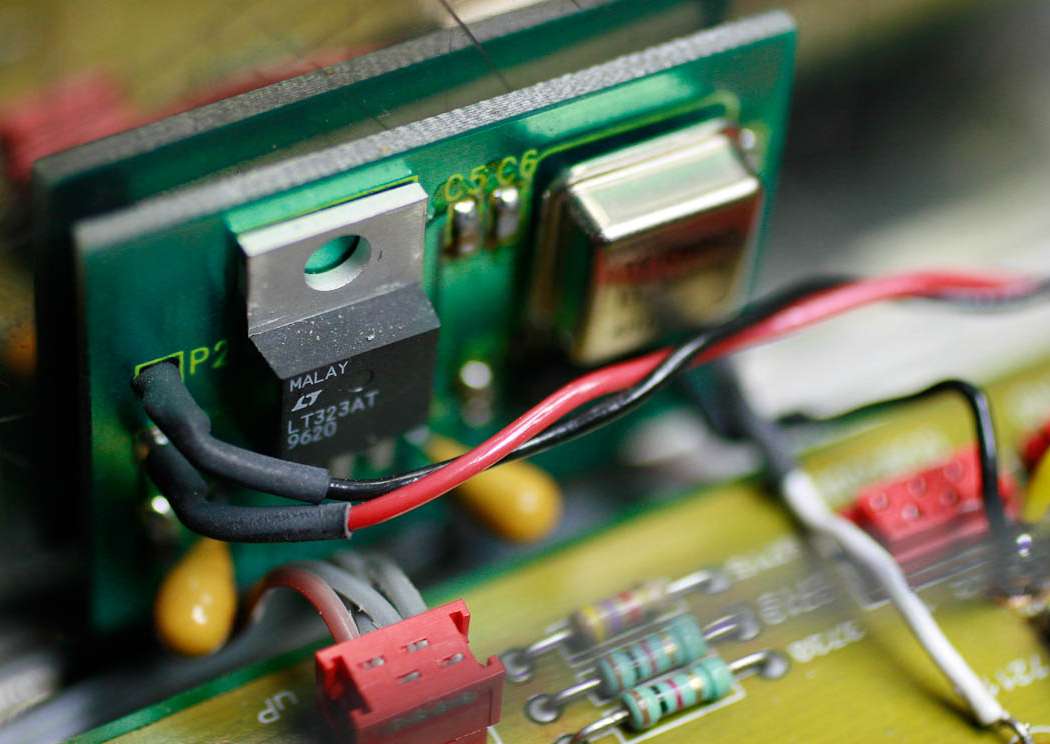
This is trichord2 clock.
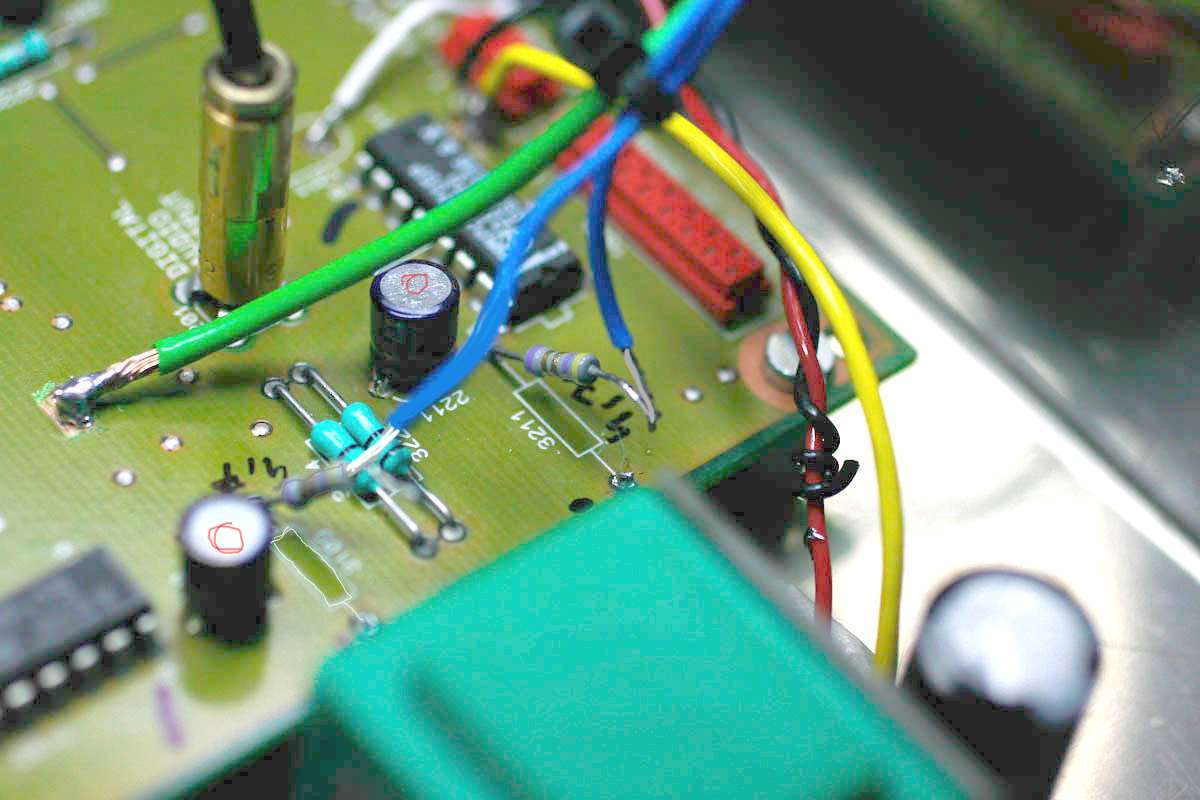
The blue wires come from power-pack.
The normal design in this product, and in many other CD boards is - one
common voltage source of +5V, and near every chip which is a power
consumer - there is first a series resistor and then a small local
capacitor and then it goes to the pin of the chip. The resistor
has double role - one is like a fuse, it should burn in case of
internal chip short. Second role is noise isolation in between all
consumers. So the consumer sees first his own cap, and the external
line is feeding through the resistor. We get a half volt noise barrier.
I decided to keep them both - the resistor and the local blackgate cap.
So I lift the resistor only on the end far from chip (buzz it to the
+5V input of power to the whole PCB) and I feed the power-pack to
the lifted resistor.
The green wire is the power pack ground. I scratched off some lacquer
from the ground plane of the main PCB and I soldered the ground to the
bare copper
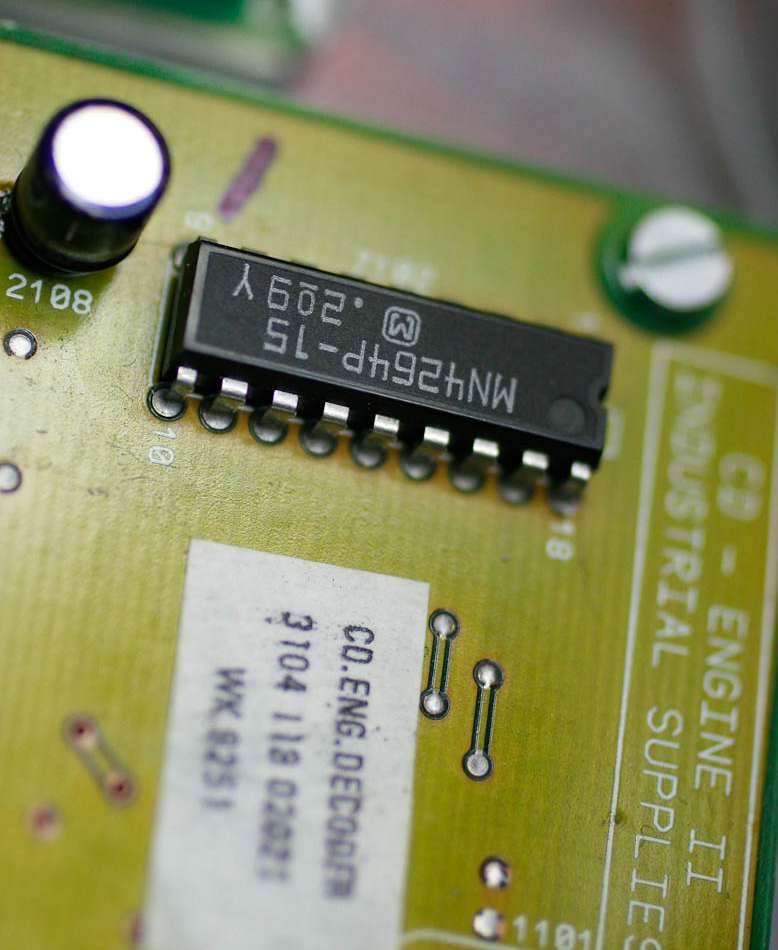
The capacitor marked 2108 feeds the +5V to the chip on the above photo.
I am not sure about the chip role - but whatever it does - the power
supply pin shows huge scale of modulation, noise and cross talk. So it
is no good for the other chips on this board.
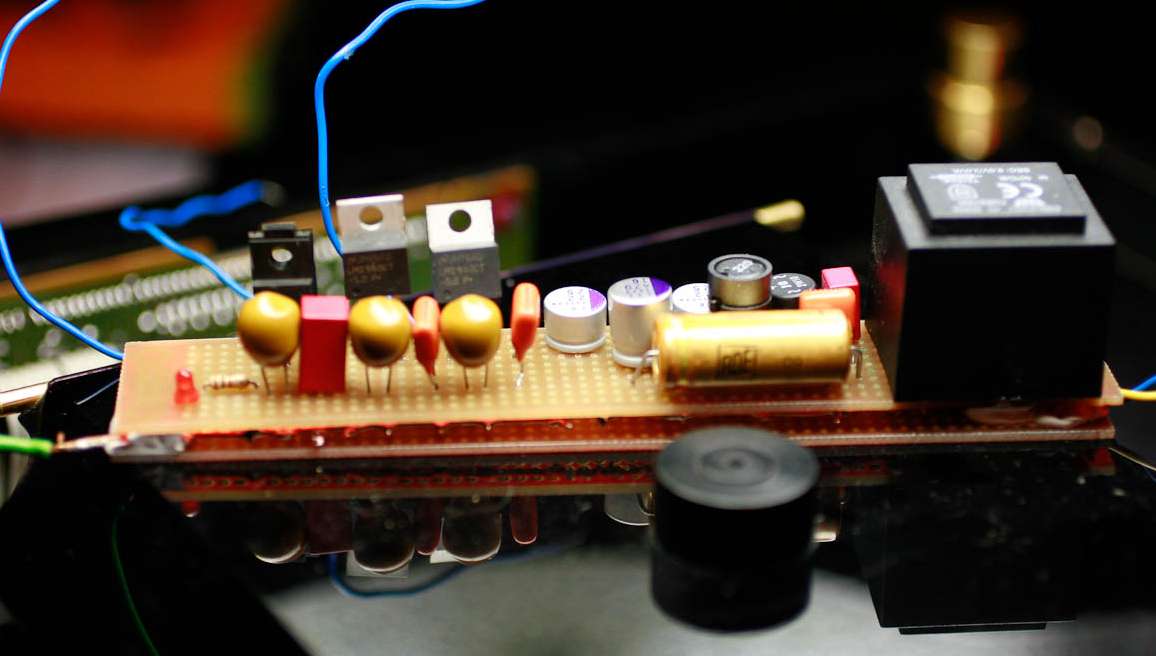
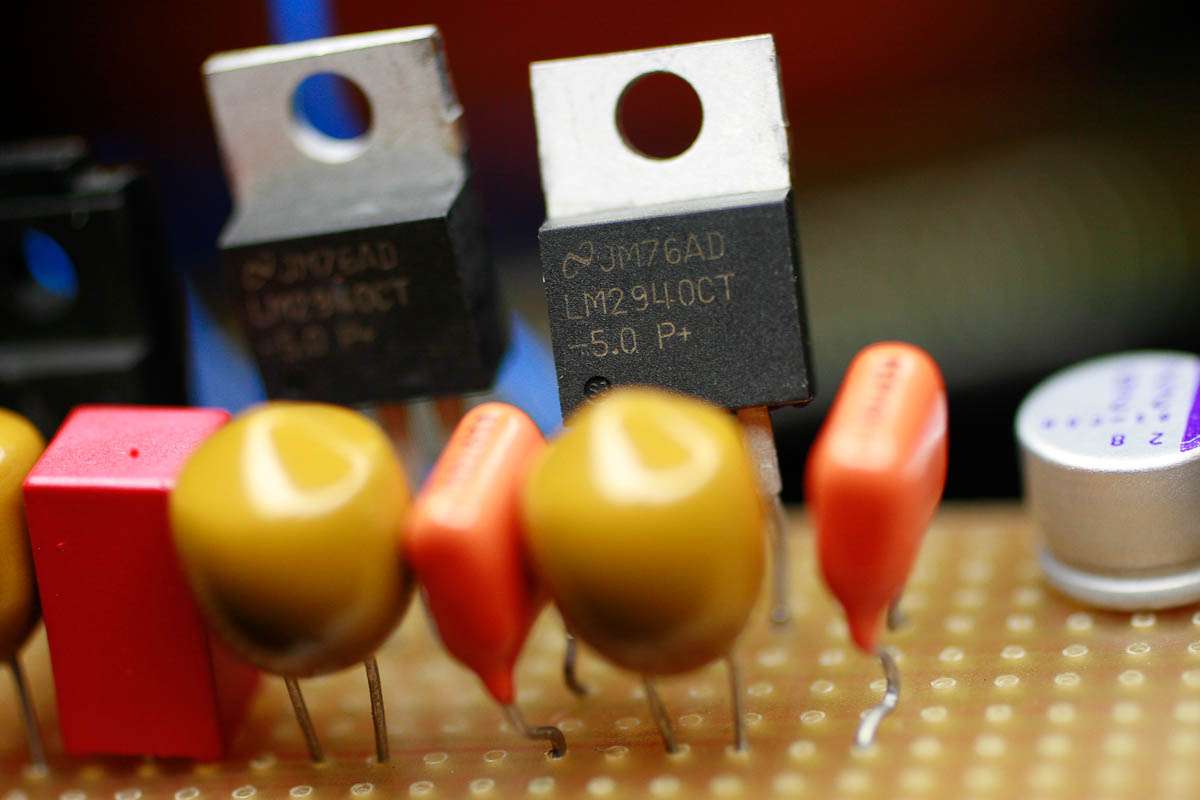
I used a mix of tantalum caps, Vishay MKP orange drops, wima red cubes,
and Sanyo Os-con SEPC and SA series. One huge roedestein as main raw
reservoir and a coil for RFI filtering too.
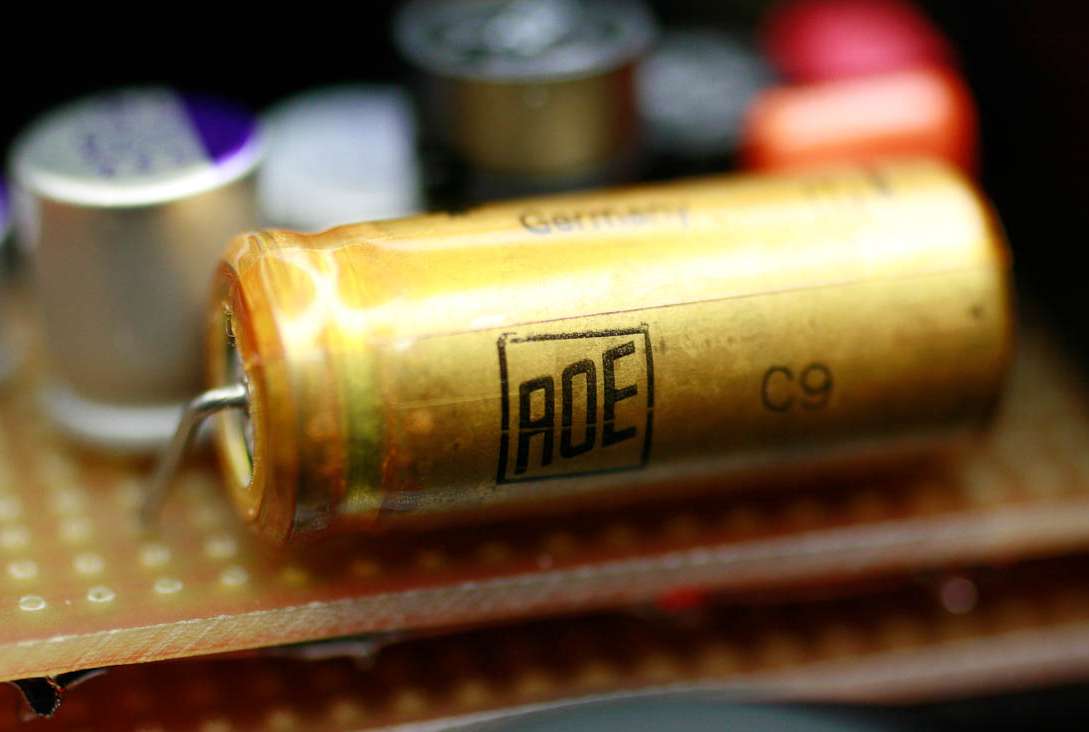
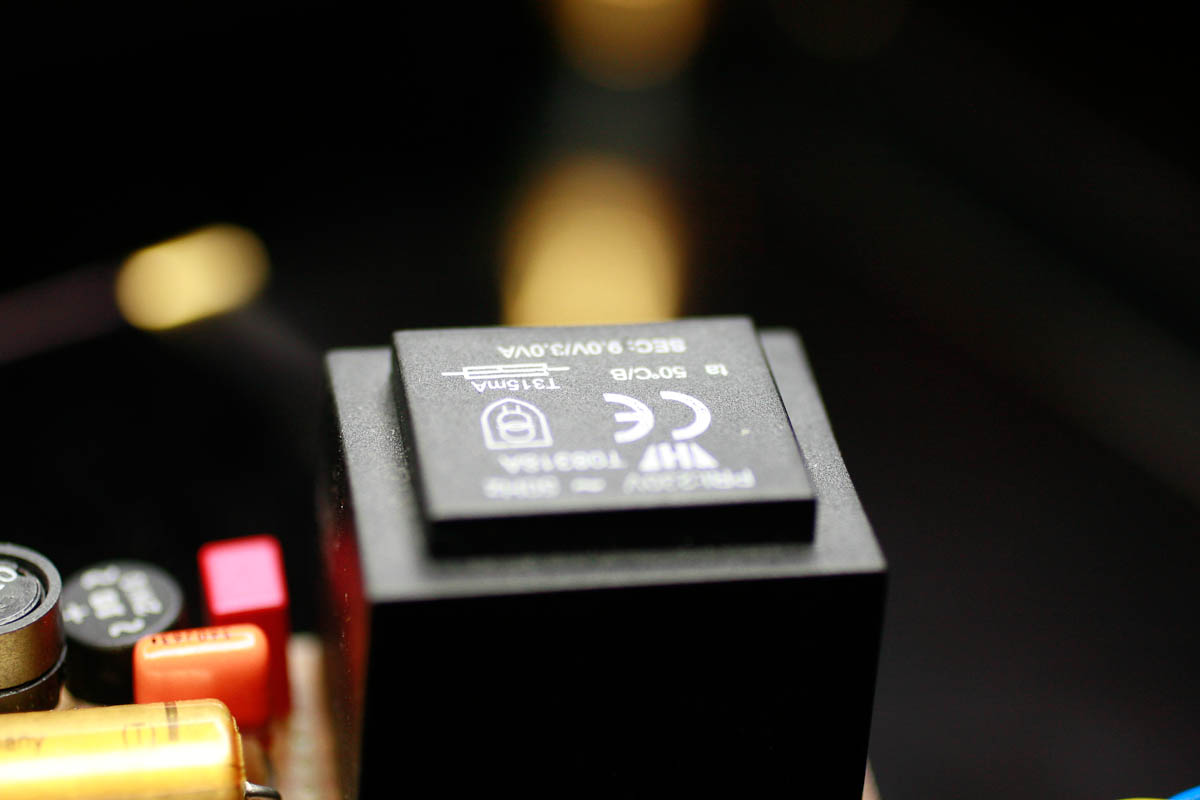
For these three chips - a small transformer was enough - just 3 VA. So
at 9 V it has 300 mA. The chips consume: 20. 40 and 80 mA. Together -
140 mA. So we have some reserve for the regulators for their own waste.
And some headroom.
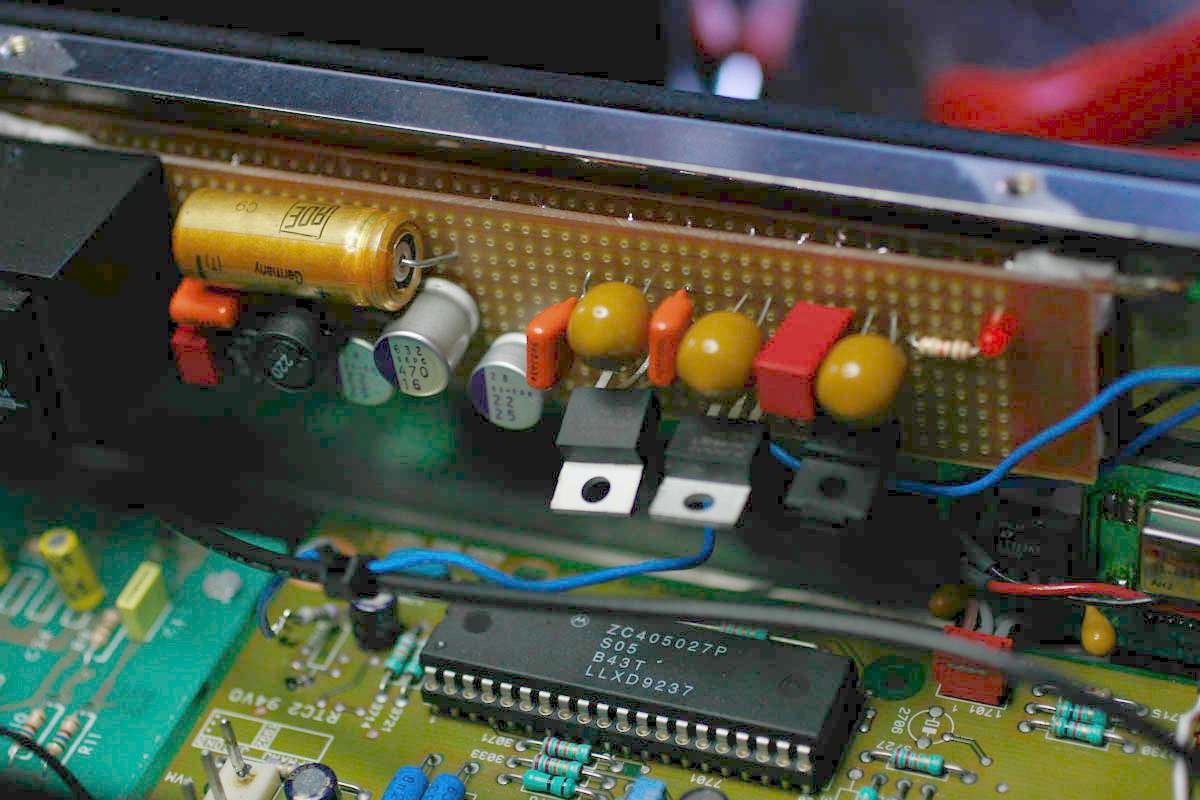
Power pack installed close to the power consumers.
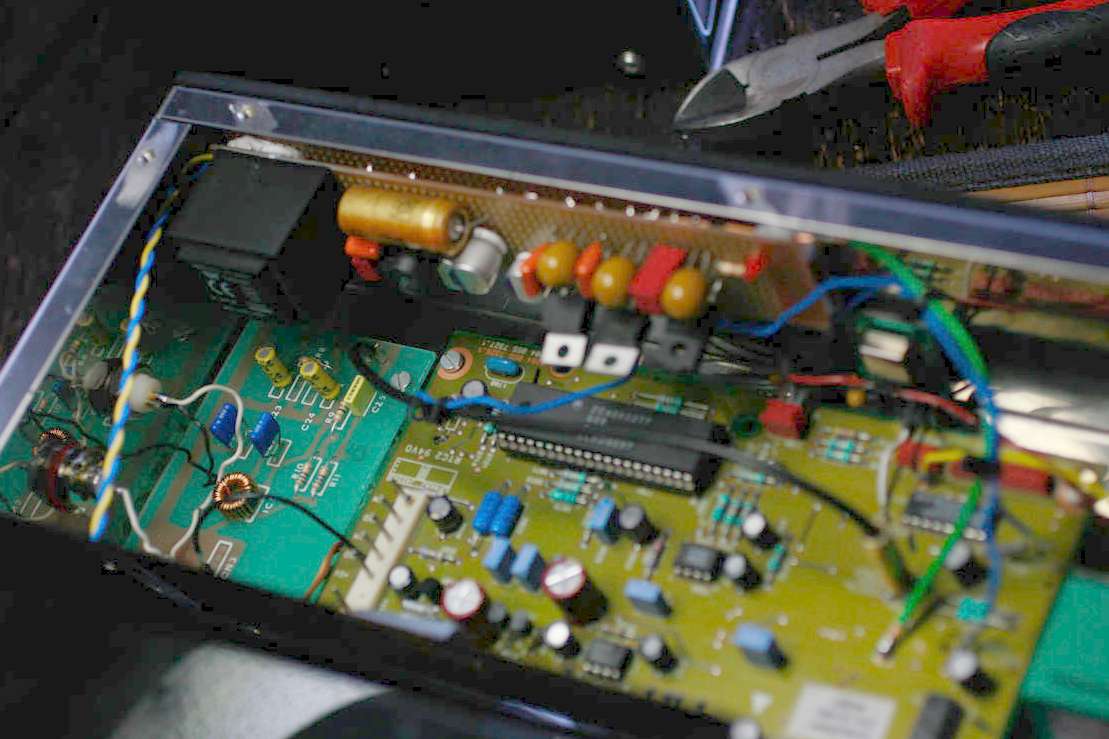
The power pack installed.
Below you will see the most HORRIBLE s/pdif trace ever - from stock
Mephisto.
WHAT IS THIS SUPPOSED TO BE ?!?!?!?!?!
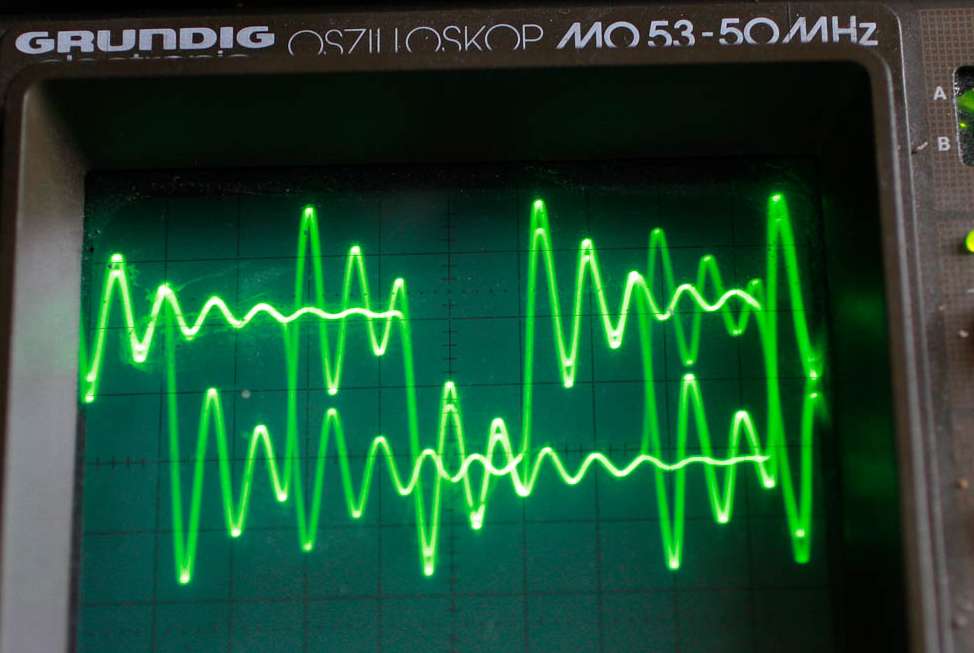
The below trace is after my mods:
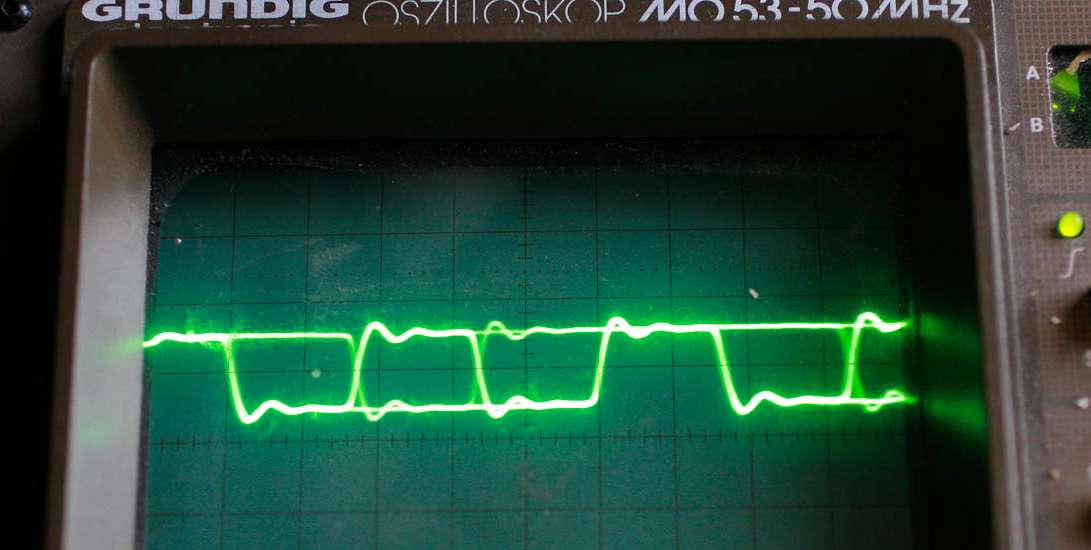
It is not perfect but soooo much better. It starts to resemble a
square wave. ad it DOES sound better.
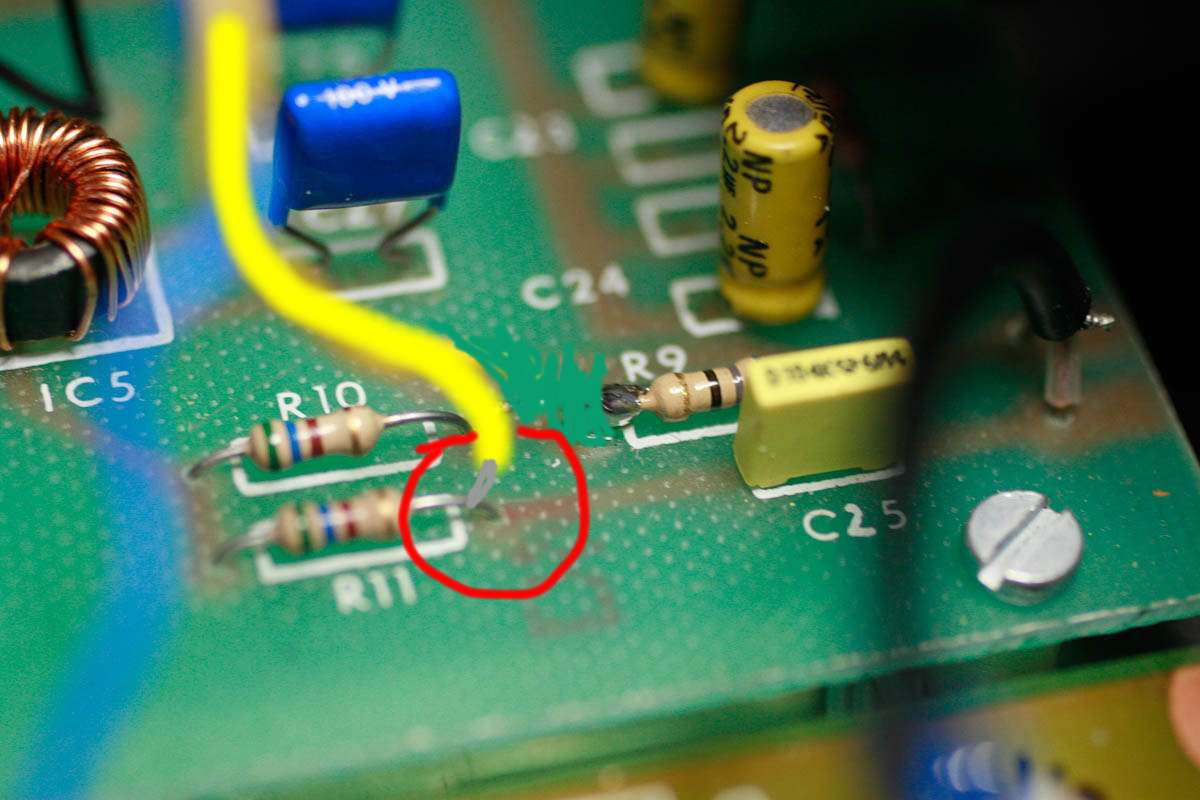
The RCA output was wired from the centre by the yellow cable to this
new signal stealing point.
Apparently the transformer IC5 is a horribly inadequate one. Shame
Audiomeca. This is what distorts your signal.
I took it from just before the transformer. Since it was too strong, I
installed two resistors there:
Series 250 Ohms and after - parallel 75 Ohm. Both sit on the RCA
itself.
I suggest to cut out the toroid IC5 from there and throw it away.
After the mods - this is the FIRST CLASS player. Beautiful looking,
flawlessly working, and VERY VERY MUSICAL.
The magnitude of sound improvement is hard to believe. On the very
revealing 100 000 Euro horn system - the difference was mind blowing.
So I went full circle and my mind was blown by mephisto for the second
time.
I am very very proud of this mod - by no means it was easy to challenge
the legendary product, made by hand by a specialist. This is not like
tuning the cheap grundig player.
August 2009.





























